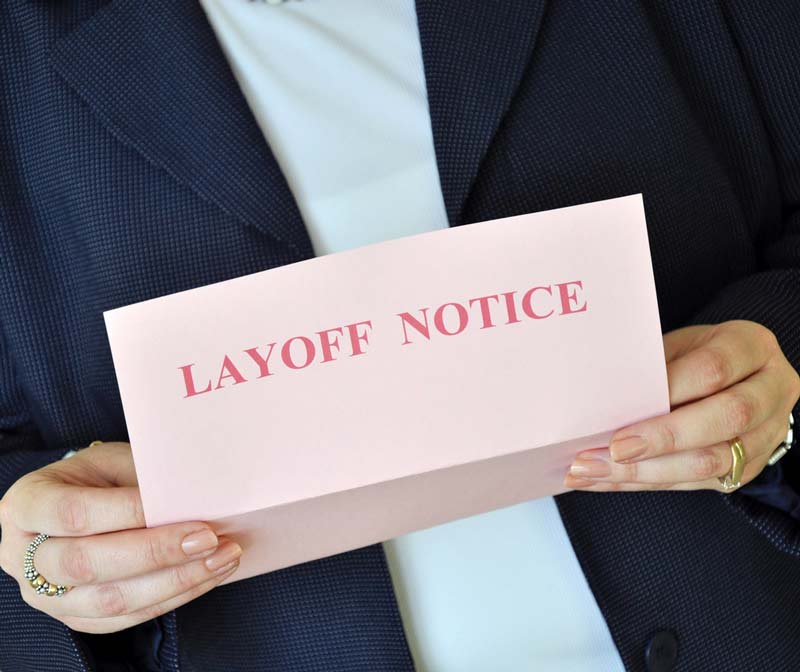Job layoffs are an all-too common experience of American work life. Some 20.2 million people looked for work after being laid off in 2024, according to the U.S. Bureau of Labor Statistics.
But knowing what to do when you get laid off can make all the difference in how long you’ll be sidelined from work. Here, we’ll give you 11 actions to get yourself back on someone’s payroll. From digging into your medical insurance coverage to updating your resume to focusing on self-care practices, these tips can increase your chances of a soft landing from an abrupt fall.
Some suggestions worth investigating:
- Ask HR for a “laid-off” letter
- Ask about insurance coverage
- Check on your final paycheck
- Review your 401k contributions
- Ask about severance
- File for unemployment
- Put the internet to work for you
- Update your resume
- Develop your personal brand
- Take time for self-care
- Start your job search
There are things you should do when you’re laid off.
But there’s also one thing you must not do: “Don’t immediately sign anything the company asks you to,” says corporate veteran Colin McLetchie, president of Arlington, Va.-based professional coaching consultancy Five Ways Forward. “Find out how much time you have to review [the] materials and take that time to make sure everything is clear. Whether you can negotiate anything has a lot to do with factors outside your control. So, prioritize your asks, work with a lawyer or other expert, and make your asks in time for them to be considered before the signing deadline.”
1. Request a ‘Laid-Off Letter’ from Human Resources
If you lost your job for reasons outside your control — restructuring, economic reversals, mergers, buyouts, relocations, and so on — a layoff letter that explains the circumstances to you (and prospective employers) may be part of your farewell package.
Read it carefully for errors or omissions. If the letter gets any significant details relating to your separation wrong or overlooks important contributions made by you or your team, point it out to someone in Human Resources. Then ask politely for a revision.
If the letter reads like boilerplate communication — that it could be in anyone’s farewell package — ask HR for a letter that addresses your specific situation. After all, it will benefit the company if you find employment soon.
If you don’t receive a layoff letter, ask for one. It’s one thing to tell prospective employers that you were part of a reduction-in-force, but another to provide evidence that you were not fired.
Beyond a layoff letter, ask HR for another tool for your upcoming job search. “Ask for a recommendation or referral from your previous employer,” says Lilia Stoyanov, CEO of Transformity, an HR software and freelance platform.
2. Inquire About Your Health Insurance Benefit
How long you are covered under your employer-sponsored medical insurance plan hinges on how far in advance you pay your premiums. Typically, employers pay one month in advance, which is welcome news for those laid off early in the month and not so much for those laid off near the end.
Your separation package should describe your health insurance status and options, but don’t be shy about asking to have insurance details clarified to your satisfaction.
Health Benefits Option No. 1: If you were laid off from a company that had 20 or more employees the prior year, COBRA — the Consolidated Omnibus Budget Reconciliation Act — lets you continue coverage for you and your family for up to 18 months. However, COBRA can get expensive, especially if you enjoy a benefit-rich plan. You may be required to pay up to 102% of the cost to the plan.
Health Benefits Option No. 2: Under the Affordable Care Act, you may shop for an individual health care plan on state or federal exchanges. With your income temporarily slashed, you may qualify for a substantial subsidy. Losing your job is a “life event” that allows you to apply for insurance within 90 days of your last day on the job.
3. Collect — Or Check On — Your Final Paycheck
Depending on the circumstances of your layoff, you may receive your final paycheck the same day you leave the company. Make sure it’s for the correct amount and that all the deductions are in order.
If you’re part of a mass layoff, you will work for at least two more months before your last paycheck arrives. The federal Worker Adjustment and Retraining Notification Act (WARN Act) requires employers to provide 60 days’ notice, during which all wages and benefits will continue to flow as usual.
Meanwhile, break out the employee handbook to find out how the company treats unused vacation/sick days or PTO (paid time off). State laws vary about compensating employees for unused time off, but many companies compensate for banked vacation/PTO.
4. Review Your 401(k) and/or Pension Plans
If you have a 401(k) with your former employer, you have options what to do with that money.
- Leave it in your former employer’s plan. If you have at least $5,000 in your account, chances are you can let it sit, invested, right where it is. Consider this a temporary solution. If you have less than $5,000, your employer can force you to close the account or transfer your money to a rollover Individual Retirement Account (IRA).
- If your next employer offers a 401(k) plan, find out whether you have the option to merge your old plan with the new one. If so, you’ll get your retirement investments back under one roof without suffering tax penalties.
- Open a rollover IRA and drop your 401(k) money there. You can choose from a variety of investment options — stocks, bonds, mutual funds, real estate investment trusts, and so on — or you may simply select a “lifecycle fund,” which bases investments on your target retirement date.
- Cash out your 401(k). We mention this only because it is an option, although it’s a lousy one. You will you injure your retirement plan, perhaps beyond repair, and pay a premium for grabbing the money now. Federal (and, where applicable), state, and local income taxes will be due on the lump sum, plus a 10% penalty for early withdrawal.
If your former company had a traditional defined-benefit plan — that is, you work a certain number of years at a certain salary level, and at retirement you can expect a predictable monthly payout — you may have options here, too.
Much of your decision will pivot on how old you are and how long you’ve been with the company. For those not fully vested — that is, they weren’t with the employer long enough to qualify for full retirement benefits — it might be wise to take a lump-sum payout, if offered. (But don’t spend it! Instead, invest it in a rollover IRA and let it grow.)
Are you close to retirement? If you’re vested, if research shows your former company is on firm financial footing and you fancy the idea of regular payments, you could be happier waiting for your annuity to kick in.
» Learn More: Saving and Investing for Life
5. Investigate a Severance Package
There’s usually not much wiggle room here. Most companies have had their severance packages (if any) reviewed by legal staff, and unless the work is sloppy, what you’re offered probably is what you’ll get.
Still, examine the details. Consult an attorney specializing in labor law if you suspect the package falls short of industry standards or if it fails to follow guidelines spelled out in the employee handbook.
Ask questions. What’s behind the layoffs? What positions are being eliminated? Does the company appear to be targeting readily identifiable groups (older workers, gender-specific, race, national origin)?
Were you singled out for demographic reasons? Can you cite the ways you’ve been treated differently? If you can mount a plausible discrimination claim, it could bolster your negotiating position.
If the company won’t budge on its payout and your leverage is minimal, ask about other areas of help. It could come as a letter of recommendation, a guarantee that your former supervisors will provide good references when potential employers call, help with outplacement services, or a set period when your company email and voicemail will remain in service.
6. Register for Unemployment
As a former employee in good standing, you have a right to unemployment benefits. Accessing those benefits will take some pressure off your emergency fund, so sign up as soon as is feasible. Find out whether you’re entitled to the weekly $300 federal bonus that runs through September as part of the 2021 American Rescue Plan Act.
Your eligibility, the amount you’ll receive, and the time you’re covered (often 26 weeks) depends on where you live. Check with the local branch of your state’s Department of Labor and the unemployment office.
More than likely, you can apply online.
7. Put the Internet to Work for You
Effective networking is key to the optimal job search. Being savvy online will help you cover a lot of ground quickly.
“Being digitally savvy has become increasingly important,” says Kane Carpenter, director of career services for Employment BOOST. “Understand how to play the game: Making sure your resume is getting through applicant tracking systems (ATS) and making an impression requires an understanding of technology.”
In the corporate world, LinkedIn is your online network, a digital lifeline offering a readymade conduit for effectively and efficiently spreading the news that you’re looking for that next challenge. Recruiters especially prefer LinkedIn over other social networks: 94% who use (or intend to use) social media for recruiting use LinkedIn — 30 points higher than the runner-up, Facebook.
Update your status (mark yourself as “open to work”), make sure you have the correct headers in place and that you’ve included a good photo of yourself. Consistent research shows that people who use a quality picture on LinkedIn get jobs faster and make more money.
Set up job alerts on LinkedIn, Glassdoor, Indeed and other online job boards, including industry-specific boards. You’ll waste less time surfing for jobs because they’ll come directly to your inbox.
If you’re not already doing so, follow industry influencers on LinkedIn and other social media platforms (Facebook, X, Threads, Instagram, etc.).
Finally, leverage your built-in personal network on Facebook. Your friends will love to help you land on your feet, so share your job-search news.
Looking for a new job IS your interim job. Dedicate time each day to various parts of your search.
8. Reinvigorate Your Resume
If you’re not someone who routinely reviews and updates his/her resume, now is the time. Considering a career change? You’re not alone; the pandemic forced millions of Americans to reassess their careers. If this includes you, shift what you emphasize.
Don’t know how to begin? Type “resume builder” into your favorite search engine, and off you go.
Uncertain what your strengths are? Ask coworkers, friends, and other associates for an honest evaluation. They may see qualities you have overlooked.
9. Develop Your Personal Brand
One of your strategies in looking for a job is to set yourself apart from the crowd. No one has the exact skills that you have, and that’s your selling point — your brand. Build on it.
Post on your blog, your LinkedIn or Facebook pages about topics you’re passionate about. This will help you stand out from the crowd, and it will help you build trust and credibility with those who read. Promote your posts with links on other social media platforms.
Comment on posts with others on social media who are influential in the work niche you want to join.
Besides bolstering your LinkedIn and Facebook pages, consider building a personal website — a place where you can tell potential employers about all the wonderful things you’ve accomplished. Include a nice photo or two plus the best ways to contact you. Consider securing a VOIP number so that you don’t have to put your everyday phone number on the internet.
Order business cards to hand out whenever you come across someone who may have a job lead. Don’t use business cards from your former company with scratch-outs and handwritten updates.
Include your name, non-work telephone number, specialty email address (set up an account exclusive to your job search), a target job title, (Senior Customer Opportunity Manager; Director of Troubleshooting), a unique branding statement, and your LinkedIn profile URL.
Don’t neglect the personal touch, says San Francisco-based networking strategy coach Stephanie Thoma: “Technology has changed job hunting since the Great Recession, and face-to-face communication and networking [is] more novel when it was once the norm.
“Take this opportunity to get face time with people at networking events, targeting attending events at the HQ of a company you’d like to work for, or where they are a sponsor or have a speaker on the panel.”
While you’re at it, scrub your other social media accounts of embarrassing, compromising and unprofessional posts.
10. Take Time for Self-Care
We probably should have mentioned this at the top: Take a breath. You’ve suffered a blow, and you hurt. You may be angry. In fact, 1 in 3 Americans report that they have layoff anxiety, according to a survey from lender Clarify Capital.
It’s OK to grieve the loss of your job, especially when you ultimately have no power to influence events.
“When you’re laid off, it’s important to embrace the way you feel and surrender to feeling sad, excited, angry or whatever emotion you’re feeling,” says Keri Ohlrich, CEO of the Abbracci Group, a Los Angeles-based HR consulting firm.
As you grieve and vent to your closest confidantes, moderate what you say to the rest of the world about your former employer. Muster as much professional class as you can to put your experience in a positive light: what you learned, what you achieved, the colleagues you supported and who supported you, and why you’re a better employee for the experience.
In the early stages, there’s not much over which you have ultimate influence, except the attitude you show the world. Show it an attitude it would like to work alongside.
It’s also important to keep your expectations in check. Finding the right job when you don’t have a job can become a drawn-out process – much longer than you’d prefer.
Recruiting professionals counsel that for every $10,000 you make in salary it will take that many months to find the next position that suits your interest and your income desires. So, if you make $50,000, plan on needing five months to find your next job.
Don’t beat yourself up if your job search goes longer than you think it should. Markets shift and change, both financially and what jobs are in demand — and not.
11. Start Your Job Search
As you grapple with your new reality, think hard about what you want to do next (it may be a completely new direction), how to position yourself for that opportunity (maybe take a class to hone or acquire a skill), understand your transferable skills, cultivate your network, study how to become the best interview you can be.
“If, during the interview, you are asked if you have been laid off, don’t avoid the question or provide a vague answer,” Transformity’s Stoyanov says. “Instead, be prepared and explain that the company needed to lay off a number of employees due to sluggish sales, losing market share, etc.”
Remember, you have your layoff letter as evidence.
Also, Stoyanov says, rehearse how you’ll answer the trickier question: “’Why were you among those laid off and not among those who stayed?” This is a question about your perceived weaknesses dressed up in other clothes.
Now, let your friends and social media networks know you’re in the market for that next opportunity. Email friends. Post an upbeat message across all your platforms. Don’t fret about being idled. Everyone understands about layoffs.
Play this right and ultimately you may come to see the dark day you lost your job as the springboard to the career you always wanted.
Keep this in mind, also, says layoff-veteran-turned-inspirational-speaker John Livesay: “I am still the same person whether I am being laid off or winning an award. My advice for people is to not let your self-esteem go on a rollercoaster ride based on the highs and lows of your career.”
Approach your search strategically by setting daily job search goals, learning new skills, attending industry events, networking, exploring new non-industry opportunities like side gigs and learning new job-search techniques.
It’s also important to surround yourself with supporters who can lift you up when you experience down days. You’re being tested, but plenty of people have walked this path before, and there is life on the other side of your old job — maybe even one that’s more satisfying.
After you start your search, develop a weekly routine. It will keep you on task until you’re ready to say yes to something new!
Get Help If You Are Struggling Financially
Losing a job can be a challenging experience, often leading to financial difficulties. If you find yourself in that situation, consider going through a free credit counseling session.
Credit counselors can help with creating a budget and offer guidance on debt relief solutions if needed. Their expertise can help you get a handle on your finances and navigate the financial difficulties that often come after losing your job.
Useful Resources If You Have Been Laid Off
Check out these resources to help you through the various aspects of job loss:

15 MINUTE READ
Home » InCharge Blog »
Sources:
- N.A. (2019, August 15) Study Finds Nearly Half of Employees Experience Layoff Anxiety Despite Record Low Unemployment Rates and Upward Economic Growth. Retrieved from https://www.prnewswire.com/news-releases/study-finds-nearly-half-of-employees-experience-layoff-anxiety-despite-record-low-unemployment-rates-and-upward-economic-growth-300902079.html
- N.A. (N.D.) Table 5. Layoffs and discharges levels and rates by industry and region, seasonally adjusted. Retrieved from https://www.bls.gov/news.release/jolts.t05.htm
- N.A. (2021, May 26) Layoffs at Rhode Island factory as demand for N95 masks ebbs. Retrieved from https://apnews.com/article/donald-trump-rhode-island-coronavirus-pandemic-layoffs-business-127f58458b4844c0ffbf92dbf555b571
- Reilly, M. (2021, June 3) General Mills begins job cuts in post-pandemic restructuring. Retrieved from https://www.bizjournals.com/twincities/news/2021/06/03/general-mills-2021-restructuring-job-cuts.html
- Cummins, I. (2015, February 12) One in five suicides caused by unemployment but the lead-up to lay-off hurts most. Retrieved from https://theconversation.com/one-in-five-suicides-caused-by-unemployment-but-the-lead-up-to-lay-off-hurts-most-37530
- Ju, S. (2019, August 15) 19 Fascinating Stats on Layoff Anxiety — Infographic. Retrieved from https://www.careerarc.com/blog/2019/08/19-fascinating-stats-on-layoff-anxiety-infographic/
- N.A. (ND) Continuation of Health Coverage — COBRA. Retrieved from https://www.dol.gov/general/topic/health-plans/cobra
- Green, A. (2019, July 9) What to Do If You Were Just Laid Off. Retrieved from https://www.thecut.com/article/laid-off-what-to-do.html
- Joyce, S.P. (ND) LinkedIn Job Search Guide. Retrieved from https://www.job-hunt.org/linkedin-job-search/LinkedIn-job-search.shtml

















